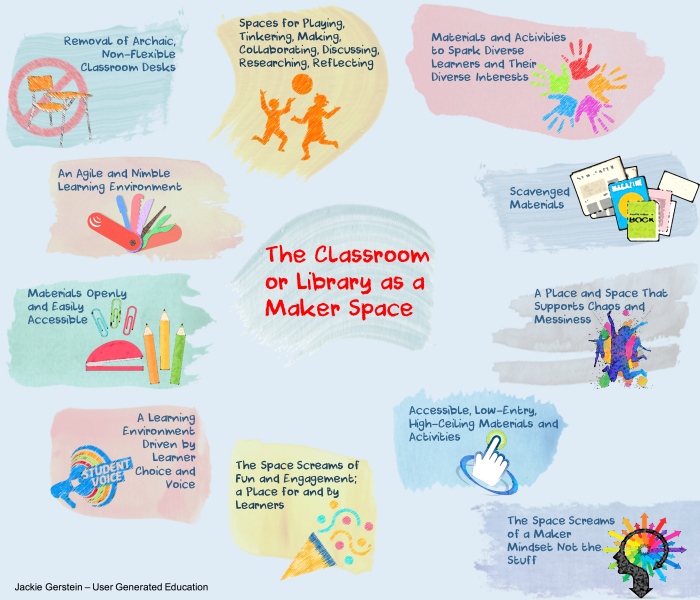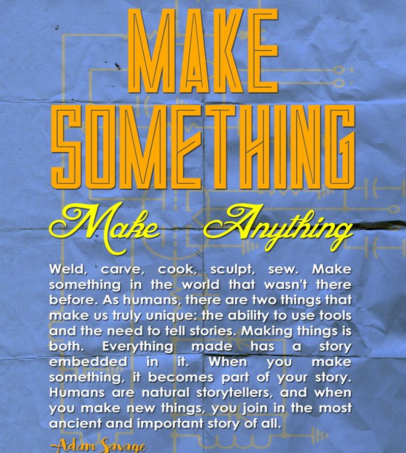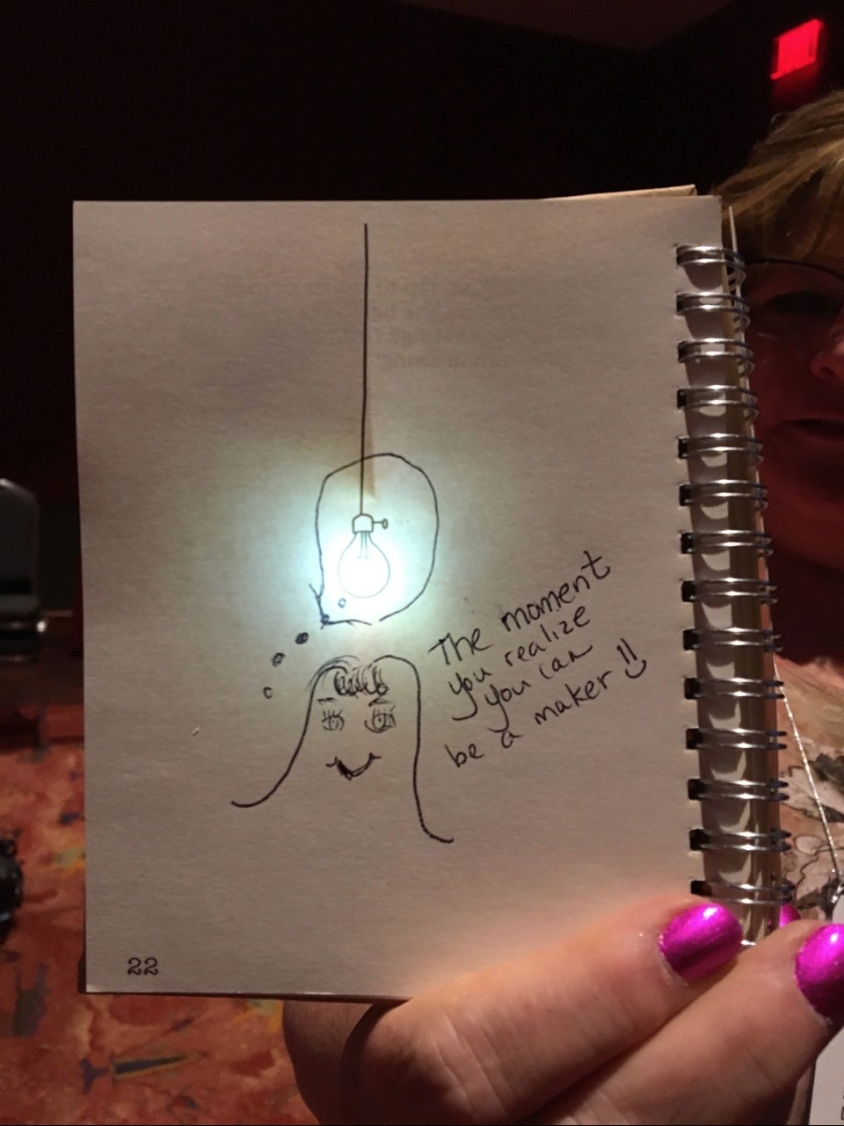The Classroom or Library as a Makerspace
Makerspaces, Maker Education, STEM, and STEAM are gaining lots of traction in Kindergarten though college level education. Articles, resources on social media, and conference presentations on these topics are proliferating at a rate that most educators are now familiar with maker education.
Once again this school year, schools will be ramping up robotics programs and opening more makerspaces, according to the latest report from the New Media Consortium and the Consortium for School Networking. As for “important developments” on the horizon, makerspaces (first listed as a trend in the 2015 report) will pick up speed over the next one to two years. As schools continue to foster 21st century skills in students in order to prepare them for the demands of a global workforce, K–12 will see the adoption of more makerspaces and research efforts to surface best benefits and practices. Furthermore, the report noted that “makerspaces were initially lauded for their role in stimulating interest in STEM fields,” but now they are often viewed as conduits to STEAM education with more emphasis on the humanities, visual arts, dance, drama and other areas of the arts (Ravipati, 2017).
Makerspaces like vocational shops and science labs are great additions to schools. They often contain the tools, machinery, and technologies associated with making – 3D printers, laser cutters, vinyl cutters, high tech robotics, vocational tech machinery. These are great for educational institutions and learners that can afford them.
Problems occur when administrators, educators, learners, and communities come to believe that maker education is synonymous with these tools and spaces. First, they may be out of budget for schools especially those serving lower income populations. Second, the regular classroom teacher or librarian may be intimidated with these advanced tools and technologies. Finally, in order to prevent maker education in becoming the educational flavor of the month, administrators, educators, and libraries need to not be seduced by these high tech tools. The longevity and sustainability of maker education will depend on making it feasible, approachable, and accessible to the masses of educators.
Public focus on maker education often centers on flashy technology, but it is more than just that. Maker education is about building educational experiences that are based in the real world, that allow student choice, and that achieve multiple objectives. Maker education can be used in a variety of ways and projects can be adjusted in scale or scope to meet individual class or student needs. The key to successful maker education implementation is finding project ideas that seamlessly integrate “making” into the lessons. In the end, maker education is all about providing engaging experiences for students that brings out the best in them in the form of problem solving and determination (https://sparkfuneducation.com/what-is-maker-education.html.).
With these broader definitions and approaches to maker education, and with the realization that maker education does not have to be about the shiny, new toys; more school administrators, librarians, and educators may be willing to embrace maker education within their own work settings. A classroom or library can be at least partially transformed into its own makerspace, a space for powerful student learning by doing the following actions workable and realistic for most librarians and educators:
A classroom or library can be transformed into its own makerspace, a space for powerful student learning by doing the following realistic and workable actions:
- Removal of Obsolete, Non-Flexible Classroom Desks (including the traditional teacher’s desk)
- Spaces for Playing, Tinkering, Making, Collaborating, Discussing, Researching, Reflecting
- An Agile and Nimble Learning Environment
- Materials Openly and Easily Available
- Materials and Activities to Spark Diverse Learners and Their Diverse Interests
- Scavenged Materials
- A Place and Space That Supports Chaos and Messiness
- Accessible, Low-Entry, High Ceiling Materials and Activities
- A Learning Environment Driven by Learner Choice and Voice
- The Space Screams of Fun and Engagement
- The Space Screams of a Maker Mindset Not the Stuff

Removal of Archaic, Non-Flexible Classroom Desks
The image that often comes to mind about the classroom desk is one that features a plastic chair with chrome legs and a fiberboard tabletop that partially encloses a student’s body (for a history of the classroom desk, see A Visual History of School Desks). The first step for creating a classroom or library space that supports making is to get rid of these archaic pieces of furniture that seem to have been invented more for control than for learning.
The idea that students must be seated at desks working in rows is quickly becoming archaic. Technology and collaborative work environments are changing the design of learning spaces. Experts hope that the emerging paradigm will translate into improved learning spaces (Learning Environment: 20 Things Educators Need to Know about Learning Spaces).
Spaces for Playing, Tinkering, Making, Collaborating, Discussing, Researching, Reflecting
Classroom educators and librarians may wonder how they might create spaces for playing, tinkering, making, collaborating, discussing, researching, and reflecting. First and foremost, they need to develop an innovator’s mindset, one outside of the box of what a classroom should look, sound, and be like. Second, practitioners need to become intentional in insuring that a full spectrum of making skills, attitudes, and knowledge is offered to learners. What will follow is educators and librarians who are creative, innovative, and resourceful in creating spaces that can offer a variety of learning activities. The types of desired learning activities should drive how the learning space should be set up as discussed in the case studies reported by the Hechinger Report article, Personalized Learning: Why Your Classroom Should Sound Like A Coffee Shop:
As a first step, they began with ideas and used them to define the space. Searching questions such as “What types of activities will define this flexible space?” were used to escape the constraints of the physical space and get beyond our own set of normal limitations.
An Agile and Nimble Learning Environment
The intentional use of flexible seating that form agile and nimble learning spaces support the learning intentions discussed in the previous section.
An agile learning environment is an educational playground that is intentionally designed to be adjustable, exchangeable and moveable. The learning space is designed to support idea generation, collaboration and experimentation. agile learning environments ultimately showcase how the design of a physical space, as well as the implementation of technology within that space, can shift how people communicate with one another.
The primary goal of an agile learning environment is flexibility. The furniture in the space, and the technology used within it, are flexible so that it can be configured and re-configured to suit different approaches to learning and teaching. An agile learning environment has the ability to turn a static or ‘dead’ space into a dynamic space (The primary goal of an agile learning environment).
With some creativity and flexibility, the practitioner can set up a unique, multipurpose space to serve the goals of making, the learners, and multipurpose uses specified above. The spaces become agile and nimble. There are lots of resources that discuss flexible seating. Here is a ScoopIt aggregate of resources http://www.scoop.it/t/flexible-seating-1
Affordable and Scavenged Materials
There are so many avenues for acquiring materials for the classroom or library seeking to be at least a part-time makerspace.

Once educators open themselves up to all of the possibilities of making, they will find free materials everywhere – cardboard at stores; recycled plastic bottles at school or the local recycling center; the storage closet at school where all of the old science kits are stored (I’ve found them at every school where I work) with all kinds of making supplies; old technologies and appliances for learners to take apart and build new inventions

Affordable Materials Openly and Easily Accessible
In a learner-centered classroom environment, materials are displayed openly – being accessible to the learners on an as-needed-when-needed basis. Both of the elementary schools where I work have general consumables for educators (and I believe it’s true for most schools): xerox paper, butcher block paper, crayons, scissors, tape, markers, rubber bands, paper clips. These materials are stored openly in bins in cubbies for my learners.
Materials such as these can provide a foundation for making; brainstorming, prototyping, reflecting and should be available for learners to use for their making activities without asking the teacher. Having them displayed can spark learners’ ideas. So when a learner says, “I need some paper.” (They ask because of their previous school experiences.) My comment back is, “Then go get it.”
Materials and Activities to Spark Diverse Learners and Their Diverse Interests
The maker education and maker spaces movements are way too often symbolized by the machines; 3D printers, laser cutters, high tech components (Raspberry Pi and Arduino) and way too often it is white males who are attracted to these machines. In order to respect the diverse learners represented by gender, age, ethnic and racial background, then first, the definition of making needs to be expanded. As Adam Savage of Mythbusters fame noted in his 2016 Bay Area Maker Faire talk:
What is making? It is a term for an old thing, it is a new term for an old thing. Let me be really clear, making is not simply 3D printing, Art Lino, Raspberry Pi, LEDs, robots, laser and vinyl cutters. It’s not simply carpentry and welding and sculpting and duct tape and drones. Making is also writing and dance and filmmaking and singing and photography and cosplay.
Every single time you make something from you that didn’t exist in the world, you are making. Making is important; it’s empowering. It is invigorating, but why? There are lots of results that are good that come from making. We improve the world around us. We show people how much we care about them. We solve problems, both personal and societal (Adam Savage’s 2016 Bay Area Maker Faire Talk).

With this expanded definition of making, it follows that the activities and materials in the classroom or library should reflect the diverse learners and their specific interests.
A Place and Space That Supports Chaos and Messiness
Traditional classrooms and libraries are often marked by students at their desks completing their learning tasks quietly, independently with as little movement of possible. This is opposite of what happens in a making environment. The classroom or library becomes loud, seemingly chaotic, and messy, but authentic and engaged learning is often messy.
Learning is often a messy business. “Messy” learning is part trial and error, part waiting and waiting for something to happen, part excitement in discovery, part trying things in a very controlled, very step by step fashion, part trying anything you can think of no matter how preposterous it might seem, part excruciating frustration and part the most fun you’ll ever have. Time can seem to stand still – or seem to go by in a flash. It is not unusual at all for messy learning to be …um …messy! But the best part of messy learning is that besides staining your clothes, or the carpet, or the classroom sink in ways that are very difficult to get out … it is also difficult to get out of your memory! (http://www.learningismessy.com/quotes/)
Accessible, Low-Entry, High Ceiling Materials and Activities
“When discussing technologies to support learning and education, my mentor Seymour Papert often emphasized the importance of “low floors” and “high ceilings.” For a technology to be effective, he said, it should provide easy ways for novices to get started (low floor) but also ways for them to work on increasingly sophisticated projects over time (high ceiling).” Mitch Resnick in https://design.blog/2016/08/25/mitchel-resnick-designing-for-wide-walls/
I do conference presentations where I have educators and librarians make paper circuits and Gami-bots. The success rate for these projects is 100% which translates into low entry into making (I took liberty to change low low to low entry). At one of my recent workshops, one teacher made the following design out of her paper circuit which says, “The moment your realize you can be a maker.”

Similar materials can also create a high ceiling or more complex activities such as advanced art projects, most complex paper circuit projects, use of more advanced maker technologies.
A Learning Environment Driven by Learner Choice and Voice
The bottom line of setting up a learning environment based on the tenets typically associated with making is that learner voice and choice is enhanced. When choice and voice are intentionally built into learning then school and education work.
School works when students have opportunities to produce quality work about issues that matter. Education works when people have opportunities to find and develop unaccessed or unknown voices and skills. Audre Lord poignantly describes this “transformation of silence into language and action [as] an act of self-revelation.” Opportunities for flexibility and choice assist learners in finding passion, voice, and revelation through their work (Student Choice Leads to Student Voice).
The Space Screams of Fun and Engagement; a Place for and By Learners
Piaget famously noted that play is the work of children and I have the belief that all humans maintain the sense of wonder of a child. Embedding fun into making; into learning in general increases engagement, joy, creativity, innovation, and collaboration.
In our test-driven educational world of today being on task and on time in many schools leaves little time for play. Lunch periods have been shortened and days and years have been lengthened in an apparent quest to make our students into perfect little technicians, automatons who can react specifically in isolation to a set of pre- set stimuli in a consistent and certain way. Little room is left for the unexpected or the un-planned in our modern classrooms. It is a strangely disastrous way to prepare our children for a future where it appears that the only constant will be continual change. By play I do not mean little league, dance, or any other adult controlled activity. It must be kid controlled, kid directed, and kid policed for real learning about life to take place. Is it possible that our current infatuation with the concept that spending more time on something will make it better is so logical and easily observable and testable that just as logic and observation has in the past it might make people believe that the Earth is flat? (“Play is the work of children”….. J. Piaget).
Fun can be felt, seen, experienced when as soon as learners and visitors walk into the space. I love watching the faces on visitors when they enter my own classroom. They light up as they see my sofas, chairs, lamps; making supplies in cubbies in the back of the room; and most of all my learners’ work such as LED lit on student-generated posters hanging on the wall, paper roller coasters in-process of being made, and Lego creations on the Lego wall.
The Space Screams the Maker Mindset Not the Stuff
The battle cry of educators using educational technology is that the pedagogy needs to come before the technology. I am baffled, then, why I go to edtech conferences and find so many sessions on the technology, e.g., 60 apps in 60 minutes. The same seems to be true for the maker movement these days. Practitioners talk about the maker mindset and then speak of the shiny new toys they use without talking about the context – of what skills and knowledge students learn from it. For example, with the 3D printer, they might talk about the Yoda they made and I say, “So what?” It really is about having a maker mindset not about the shiny, new maker tools. It’s about the making process; about the engagement, creativity, innovation, struggles to complete a difficult task, sense of accomplishment. A cardboard box, for example, can become a chariot, rocket, robot, marble run, Foosball game, dollhouse, Hot Wheels track, house, fort, castle, game.
We must exercise the discipline to refrain from attaching too quickly to an idea just because it’s new. Making is no exception, so to truly prepare ourselves to be successful in this new venture, let’s be sure we set our students up to have the right mindset to be courageous innovators (6 Must-Haves for Developing a Maker Mindset).
With a maker mindset and some of the strategies outlined above, any classroom or library can become a makerspace.

Maker mindset can also come from reading books in a library. Where do kids learn what forts are, and rockets and chariots? My concern is that library is becoming synonymous with makerspace (which to me means legos and 3 D printers) but not books. Where do kids learn about the rest of the world? And empathy? And ideas that have come before? Let makerspace be it’s own space and the library feed the imagination.
M.C. Hawkins
July 4, 2017 at 4:34 pm
This gives courage to schools in the quiet parts of the world with classrooms or libraries that are considered obsolete.
Such spaces can be turned makerspace where discoveries and innovations as well as mind architecture can be configured for progress.
Thank you for the information
Olusola
June 18, 2018 at 2:47 pm